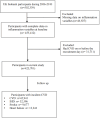Association between systemic inflammation biomarkers and incident cardiovascular disease in 423,701 individuals: evidence from the UK biobank cohort
- PMID: 40234895
- PMCID: PMC12001404
- DOI: 10.1186/s12933-025-02721-9
Association between systemic inflammation biomarkers and incident cardiovascular disease in 423,701 individuals: evidence from the UK biobank cohort
Abstract
Background: The associations between systemic inflammation biomarkers and cardiovascular disease (CVD) remain not well explored. This study aimed to investigate associations between different systemic inflammation biomarkers and incident CVD and main CVD subtypes - ischaemic heart disease (IHD), stroke, and heart failure - explore dose-response relationships, and compare their predictive performance.
Methods: This prospective cohort study included 423,701 UK Biobank participants free of CVD at baseline. Baseline neutrophil-to-lymphocyte ratio (NLR), lymphocyte-to-monocyte ratio (LMR), platelet-to-lymphocyte ratio (PLR), systemic immune-inflammation index (SII), and system inflammation response index (SIRI) were derived. Cox-proportional regression models were used to investigate the associations.
Results: NLR, PLR, SII, and SIRI was positively and LMR was negatively associated with all four of the outcomes investigated. The relationships were non-linear for all biomarkers with CVD and were linear for NLR, SII, and SIRI and non-linear for LMR and PLR with IHD, stroke and heart failure. Compared with the more established biomarkers, all four of the novel biomarkers had statistically superior predictive performance for three of the outcomes investigated (CVD, IHD and heart failure) and three of them were superior at predicting stroke. Compared to a model of CVD prediction with classical risk factors (C-index = 0.702), discrimination was improved on the addition of inflammation markers for CVD (C-index change 0.0069, 95% CI 0.0033 to 0.0107), IHD (C-index change 0.0054, 95% CI 0.0013 to 0.0095), and heart failure (C-index change 0.0153, 95% CI 0.0089 to 0.0218).
Conclusions: There were independent and dose-response relationships between the novel systemic inflammation biomarkers and CVD outcomes. Addition of the inflammation biomarkers including novel inflammation biomarkers showed improved discrimination of the traditional risk prediction model. With accumulated evidence, these biomarkers should be considered for inclusion in risk tools and prevention.
Keywords: CVD; Heart failure; Ischaemic heart disease; Stroke; Systemic inflammation; UK biobank.
© 2025. The Author(s).
Conflict of interest statement
Declarations. Ethical approval: UK Biobank received ethical approval from the North-West Multi-centre Research Ethics Committee (reference: 11/NW/03820). Consent for publication: Not applicable. Competing interests: The authors declare no competing interests.
Figures


References
-
- Zhang YR, Wang JJ, Chen SF, Wang HF, Li YZ, Ou YN, Huang SY, Chen SD, Cheng W, Feng JF, et al. Peripheral immunity is associated with the risk of incident dementia. Mol Psychiatry. 2022;27(4):1956–62. - PubMed
Publication types
MeSH terms
Substances
LinkOut - more resources
Full Text Sources
Medical

